2021 TOYOTA PROACE CITY deactivate passenger airbag
[x] Cancel search: deactivate passenger airbagPage 14 of 272
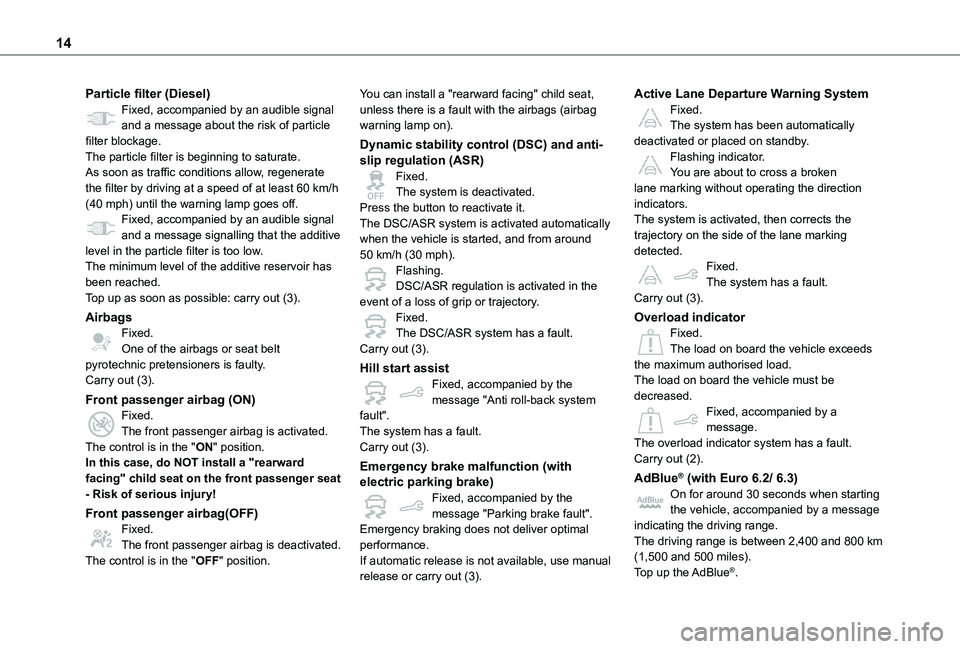
14
Particle filter (Diesel)Fixed, accompanied by an audible signal and a message about the risk of particle filter blockage.The particle filter is beginning to saturate.As soon as traffic conditions allow, regenerate the filter by driving at a speed of at least 60 km/h (40 mph) until the warning lamp goes off.Fixed, accompanied by an audible signal and a message signalling that the additive level in the particle filter is too low.The minimum level of the additive reservoir has been reached.Top up as soon as possible: carry out (3).
AirbagsFixed.One of the airbags or seat belt pyrotechnic pretensioners is faulty.Carry out (3).
Front passenger airbag (ON)Fixed.The front passenger airbag is activated.
The control is in the "ON" position.In this case, do NOT install a "rearward facing" child seat on the front passenger seat - Risk of serious injury!
Front passenger airbag(OFF)Fixed.The front passenger airbag is deactivated.The control is in the "OFF" position.
You can install a "rearward facing" child seat, unless there is a fault with the airbags (airbag warning lamp on).
Dynamic stability control (DSC) and anti-slip regulation (ASR)Fixed.The system is deactivated.Press the button to reactivate it.The DSC/ASR system is activated automatically when the vehicle is started, and from around 50 km/h (30 mph).Flashing.DSC/ASR regulation is activated in the event of a loss of grip or trajectory.Fixed.The DSC/ASR system has a fault.Carry out (3).
Hill start assistFixed, accompanied by the message "Anti roll-back system fault".The system has a fault.
Carry out (3).
Emergency brake malfunction (with electric parking brake)Fixed, accompanied by the message "Parking brake fault".Emergency braking does not deliver optimal performance.If automatic release is not available, use manual release or carry out (3).
Active Lane Departure Warning SystemFixed.The system has been automatically deactivated or placed on standby.Flashing indicator.You are about to cross a broken lane marking without operating the direction indicators.The system is activated, then corrects the trajectory on the side of the lane marking detected.Fixed.The system has a fault.Carry out (3).
Overload indicatorFixed.The load on board the vehicle exceeds the maximum authorised load.The load on board the vehicle must be decreased.Fixed, accompanied by a message.The overload indicator system has a fault.
Carry out (2).
AdBlue® (with Euro 6.2/ 6.3)On for around 30 seconds when starting the vehicle, accompanied by a message indicating the driving range.The driving range is between 2,400 and 800 km (1,500 and 500 miles).Top up the AdBlue®.
Page 54 of 272
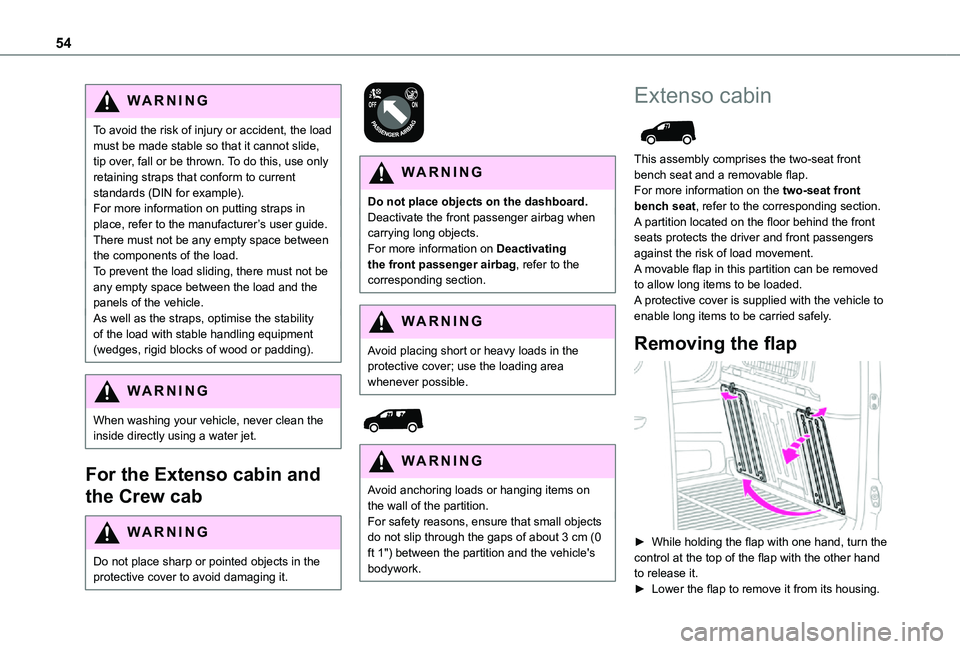
54
WARNI NG
To avoid the risk of injury or accident, the load must be made stable so that it cannot slide, tip over, fall or be thrown. To do this, use only retaining straps that conform to current standards (DIN for example).For more information on putting straps in place, refer to the manufacturer’s user guide.There must not be any empty space between the components of the load.To prevent the load sliding, there must not be any empty space between the load and the panels of the vehicle.As well as the straps, optimise the stability of the load with stable handling equipment (wedges, rigid blocks of wood or padding).
WARNI NG
When washing your vehicle, never clean the inside directly using a water jet.
For the Extenso cabin and
the Crew cab
WARNI NG
Do not place sharp or pointed objects in the protective cover to avoid damaging it.
WARNI NG
Do not place objects on the dashboard.Deactivate the front passenger airbag when carrying long objects.For more information on Deactivating the front passenger airbag, refer to the corresponding section.
WARNI NG
Avoid placing short or heavy loads in the protective cover; use the loading area whenever possible.
WARNI NG
Avoid anchoring loads or hanging items on the wall of the partition.For safety reasons, ensure that small objects do not slip through the gaps of about 3 cm (0 ft 1") between the partition and the vehicle's bodywork.
Extenso cabin
This assembly comprises the two-seat front bench seat and a removable flap.For more information on the two-seat front bench seat, refer to the corresponding section.A partition located on the floor behind the front seats protects the driver and front passengers against the risk of load movement.A movable flap in this partition can be removed to allow long items to be loaded.A protective cover is supplied with the vehicle to enable long items to be carried safely.
Removing the flap
► While holding the flap with one hand, turn the control at the top of the flap with the other hand to release it.► Lower the flap to remove it from its housing.
Page 57 of 272
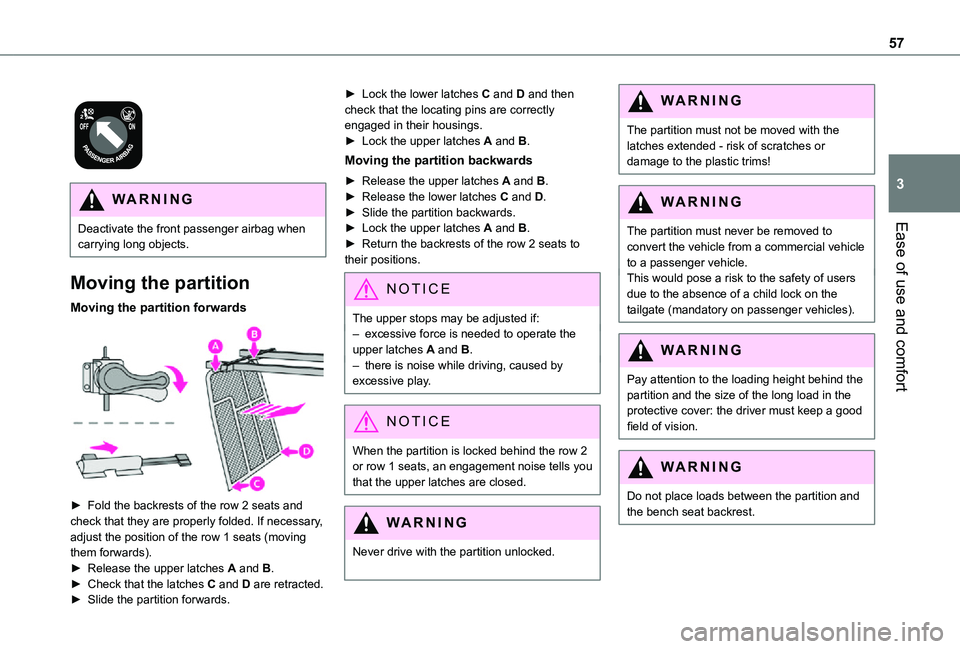
57
Ease of use and comfort
3
WARNI NG
Deactivate the front passenger airbag when carrying long objects.
Moving the partition
Moving the partition forwards
► Fold the backrests of the row 2 seats and check that they are properly folded. If necessary, adjust the position of the row 1 seats (moving them forwards).► Release the upper latches A and B.► Check that the latches C and D are retracted.
► Slide the partition forwards.
► Lock the lower latches C and D and then check that the locating pins are correctly engaged in their housings.► Lock the upper latches A and B.
Moving the partition backwards
► Release the upper latches A and B.► Release the lower latches C and D.► Slide the partition backwards.► Lock the upper latches A and B.► Return the backrests of the row 2 seats to their positions.
NOTIC E
The upper stops may be adjusted if:– excessive force is needed to operate the upper latches A and B.– there is noise while driving, caused by excessive play.
NOTIC E
When the partition is locked behind the row 2 or row 1 seats, an engagement noise tells you that the upper latches are closed.
WARNI NG
Never drive with the partition unlocked.
WARNI NG
The partition must not be moved with the latches extended - risk of scratches or damage to the plastic trims!
WARNI NG
The partition must never be removed to
convert the vehicle from a commercial vehicle to a passenger vehicle.This would pose a risk to the safety of users due to the absence of a child lock on the tailgate (mandatory on passenger vehicles).
WARNI NG
Pay attention to the loading height behind the partition and the size of the long load in the protective cover: the driver must keep a good field of vision.
WARNI NG
Do not place loads between the partition and the bench seat backrest.
Page 90 of 272
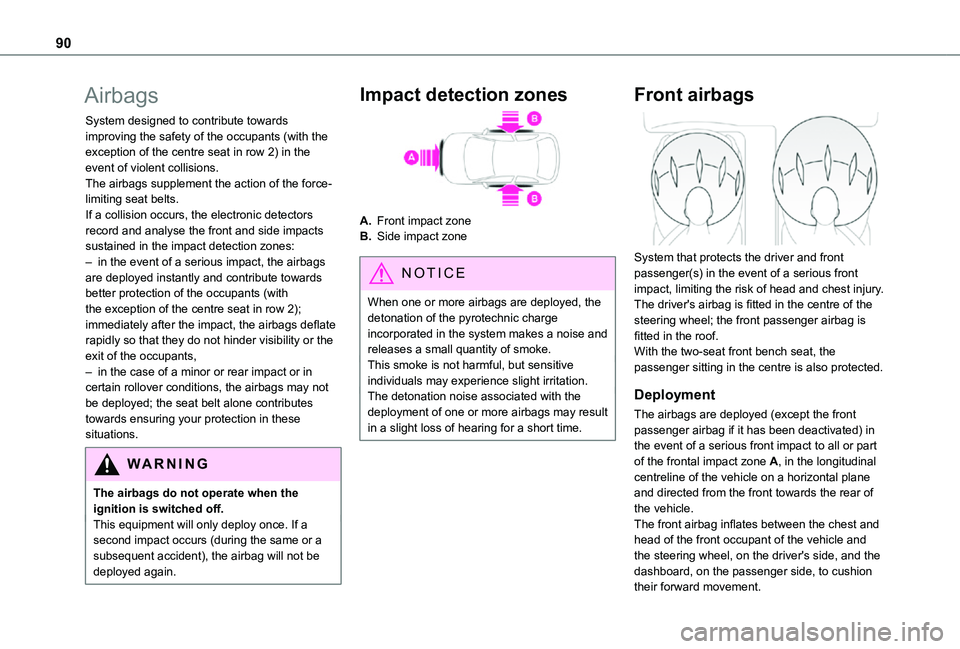
90
Airbags
System designed to contribute towards improving the safety of the occupants (with the exception of the centre seat in row 2) in the event of violent collisions.The airbags supplement the action of the force-limiting seat belts.If a collision occurs, the electronic detectors record and analyse the front and side impacts sustained in the impact detection zones:– in the event of a serious impact, the airbags are deployed instantly and contribute towards better protection of the occupants (with the exception of the centre seat in row 2); immediately after the impact, the airbags deflate rapidly so that they do not hinder visibility or the exit of the occupants,– in the case of a minor or rear impact or in certain rollover conditions, the airbags may not be deployed; the seat belt alone contributes towards ensuring your protection in these situations.
WARNI NG
The airbags do not operate when the ignition is switched off.This equipment will only deploy once. If a second impact occurs (during the same or a subsequent accident), the airbag will not be deployed again.
Impact detection zones
A.Front impact zone
B.Side impact zone
NOTIC E
When one or more airbags are deployed, the detonation of the pyrotechnic charge incorporated in the system makes a noise and releases a small quantity of smoke.This smoke is not harmful, but sensitive individuals may experience slight irritation.The detonation noise associated with the deployment of one or more airbags may result in a slight loss of hearing for a short time.
Front airbags
System that protects the driver and front passenger(s) in the event of a serious front impact, limiting the risk of head and chest injury.The driver's airbag is fitted in the centre of the steering wheel; the front passenger airbag is fitted in the roof.With the two-seat front bench seat, the passenger sitting in the centre is also protected.
Deployment
The airbags are deployed (except the front passenger airbag if it has been deactivated) in the event of a serious front impact to all or part of the frontal impact zone A, in the longitudinal centreline of the vehicle on a horizontal plane and directed from the front towards the rear of the vehicle.The front airbag inflates between the chest and head of the front occupant of the vehicle and
the steering wheel, on the driver's side, and the dashboard, on the passenger side, to cushion their forward movement.
Page 95 of 272
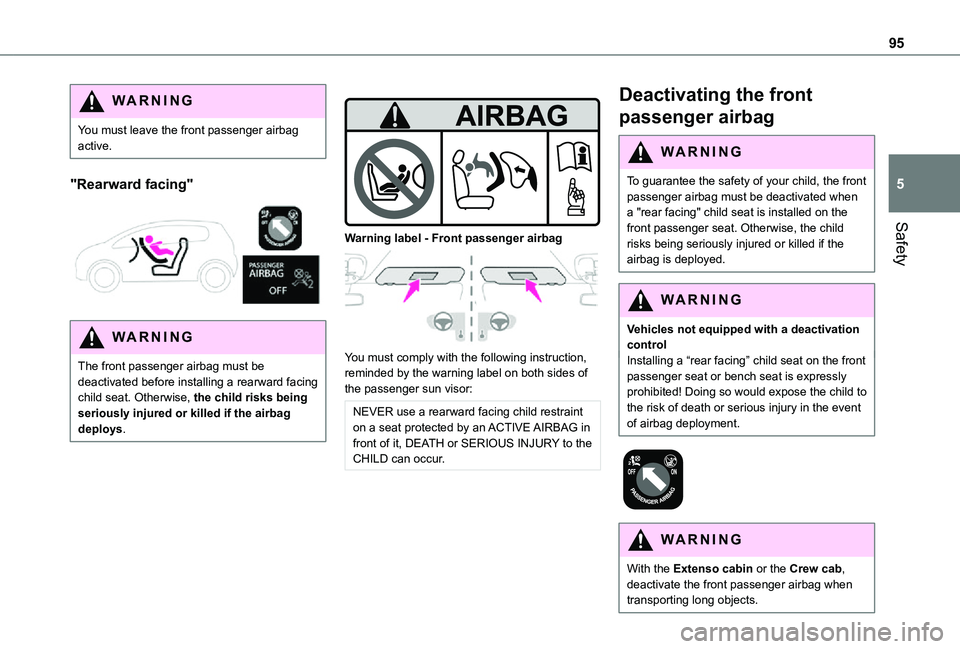
95
Safety
5
WARNI NG
You must leave the front passenger airbag active.
"Rearward facing"
WARNI NG
The front passenger airbag must be deactivated before installing a rearward facing child seat. Otherwise, the child risks being seriously injured or killed if the airbag deploys.
Warning label - Front passenger airbag
You must comply with the following instruction, reminded by the warning label on both sides of the passenger sun visor:
NEVER use a rearward facing child restraint on a seat protected by an ACTIVE AIRBAG in front of it, DEATH or SERIOUS INJURY to the CHILD can occur.
Deactivating the front
passenger airbag
WARNI NG
To guarantee the safety of your child, the front passenger airbag must be deactivated when a "rear facing" child seat is installed on the front passenger seat. Otherwise, the child
risks being seriously injured or killed if the airbag is deployed.
WARNI NG
Vehicles not equipped with a deactivation controlInstalling a “rear facing” child seat on the front passenger seat or bench seat is expressly prohibited! Doing so would expose the child to the risk of death or serious injury in the event of airbag deployment.
WARNI NG
With the Extenso cabin or the Crew cab, deactivate the front passenger airbag when transporting long objects.
Page 96 of 272
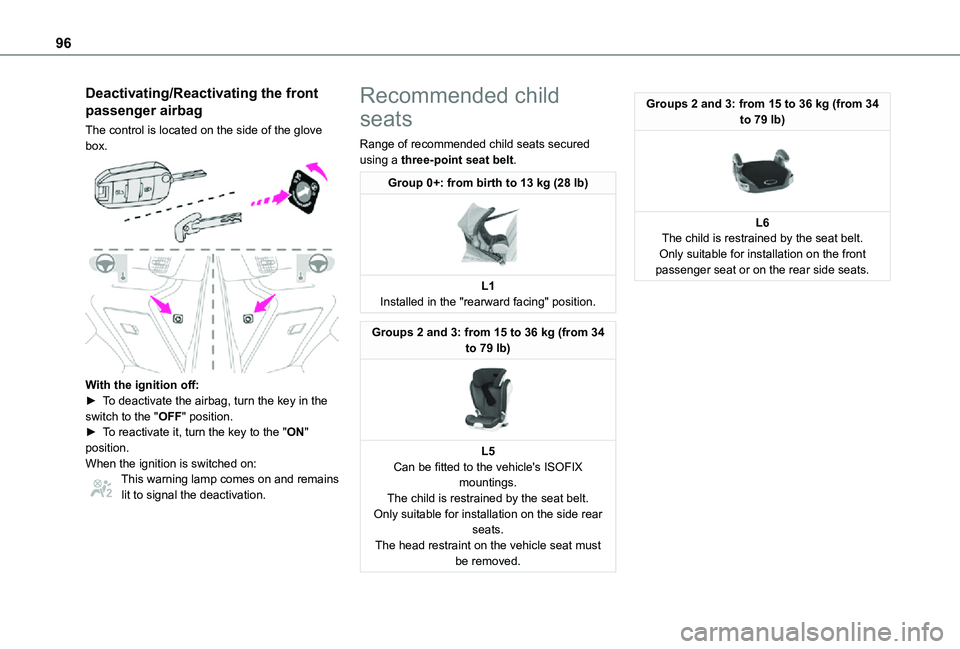
96
Deactivating/Reactivating the front
passenger airbag
The control is located on the side of the glove box.
With the ignition off:► To deactivate the airbag, turn the key in the switch to the "OFF" position. ► To reactivate it, turn the key to the "ON" position.When the ignition is switched on:This warning lamp comes on and remains lit to signal the deactivation.
Recommended child
seats
Range of recommended child seats secured using a three-point seat belt.
Group 0+: from birth to 13 kg (28 lb)
L1Installed in the "rearward facing" position.
Groups 2 and 3: from 15 to 36 kg (from 34 to 79 lb)
L5Can be fitted to the vehicle's ISOFIX mountings.The child is restrained by the seat belt.Only suitable for installation on the side rear seats.The head restraint on the vehicle seat must be removed.
Groups 2 and 3: from 15 to 36 kg (from 34 to 79 lb)
L6The child is restrained by the seat belt.Only suitable for installation on the front passenger seat or on the rear side seats.
Page 97 of 272
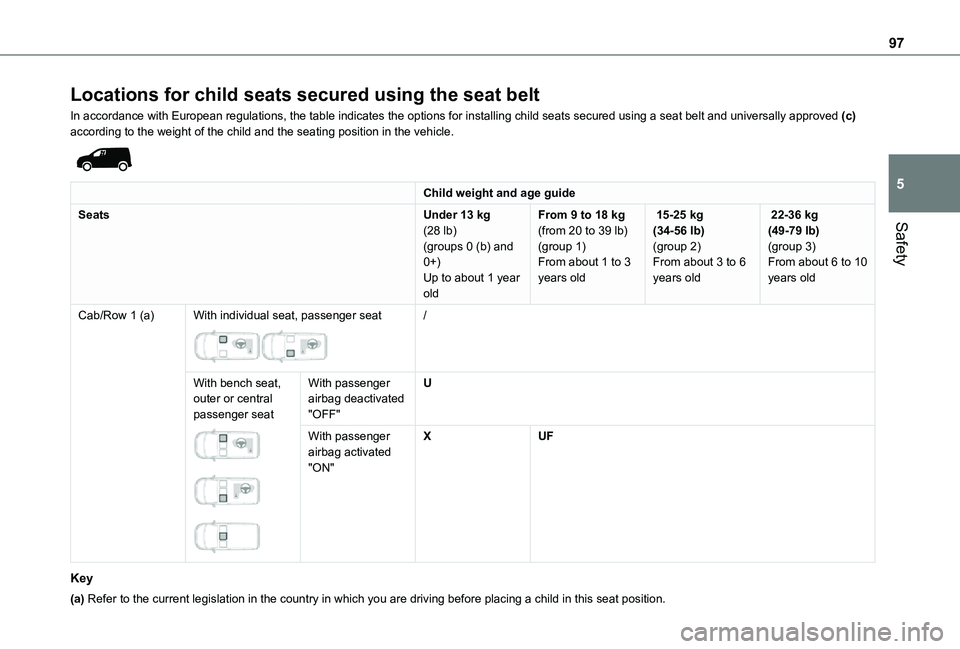
97
Safety
5
Locations for child seats secured using the seat belt
In accordance with European regulations, the table indicates the options\
for installing child seats secured using a seat belt and universally ap\
proved (c) according to the weight of the child and the seating position in the veh\
icle.
Child weight and age guide
SeatsUnder 13 kg (28 lb)
(groups 0 (b) and 0+)Up to about 1 year old
From 9 to 18 kg (from 20 to 39 lb)
(group 1)From about 1 to 3 years old
15-25 kg (34-56 lb)
(group 2)From about 3 to 6 years old
22-36 kg (49-79 lb)
(group 3)From about 6 to 10 years old
Cab/Row 1 (a)With individual seat, passenger seat
/
With bench seat, outer or central passenger seat
With passenger airbag deactivated "OFF"
U
With passenger airbag activated "ON"
XUF
Key
(a) Refer to the current legislation in the country in which you are drivin\
g before placing a child in this seat position.